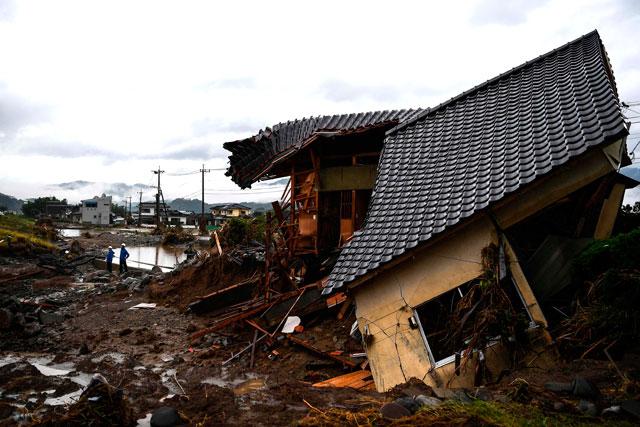- International News
- Web-2020-07-08 | 10:16 pm

Even as rescue operations continued, with 80,000 personnel already involved and more expected to join, authorities warned that more torrential rain was expected.
Japan's Meteorological Agency issued its second-highest emergency warning for heavy rain and landslides over vast swathes of the country's southwest and said "risks are rising" nationwide.
The heavy rain has caused rivers to burst their banks and sweep away bridges, while landslides have destroyed roads and buried houses, complicating access for rescuers battling to save lives.
At least 52 deaths have been confirmed in the rains that began Saturday across the worst-hit island of Kyushu, local officials said. But with around a dozen people still missing, there were fears the toll would rise further.
Government spokesman Yoshihide Suga warned that rain was forecast to continue over the next two days.
"Even a small amount of rainfall could cause a disaster. I would like people to be on full alert against landslides and floods," he said.
In the hardest-hit region of Kumamoto, on the southwest tip of Japan, disaster management official Yutaro Hamasaki said: "We are racing against time."
"We have not set any deadline or time to end the operation, but we really need to speed up our search as time is running out. We won’t give up til the end,” Hamasaki told AFP.
Abe said he would double the number of troops deployed in rescue and relief operations to 20,000, as rescuers try to reach people trapped in homes and schools.
In one school in Omuta city, dozens of children and their teachers spent a desperate night on the upper floor after the ground level flooded.
"Shoe cupboards on the group floor were swept away and shoes were floating around,” an 11-year-old girl told a local newspaper after rescuers arrived.
"Some children were sobbing because they were worried about not being able to get home and were afraid of the heavy rain.”
Locals including Kentaro Oishi, who owns a rafting business in the hot springs resort of Hitoyoshi, were drafted in to help.
"I have 20 years of rafting experience, but I never dreamed” of rowing the boat through the city, he told AFP.
"To tell you the truth, I was so scared at first when I saw the water levels rising so rapidly in the river.”
‘Filled with water’
Fourteen of the dead were wheelchair-bound residents of a nursing home unable to escape to higher ground as the waters rose.
A rescue worker who searched the facility told NHK: "The ground floor was filled with water and we couldn’t get into it. Some people managed to evacuate to the first floor. I’ve never experienced anything like this in my life.”
Further complicating evacuation efforts was the fear of spreading the coronavirus.
Japan has been relatively lightly affected by the pandemic, with just under 20,000 cases and fewer than 1,000 deaths.
But the need to maintain social distancing has reduced capacity at shelters, despite authorities issuing non-mandatory evacuation orders for 1.27 million people across Kyushu.
In Yatsushiro city, authorities converted a local gymnasium into a shelter, with cardboard walls separating families to limit the spread of the virus.
According to local media, some people were sleeping in their cars rather than risk possible infection at a shelter.
The disaster has also compounded problems for businesses already hard hit by the pandemic.
"The damage was beyond our imagination. It’s literally a bolt from the blue,” said Yuji Hashimoto, who runs a tourism bureau in Yatsushiro.
"Our hot spring resort was struggling to weather the impact of coronavirus. We don’t know what will happen to us next,” he told AFP.
Japan is in the middle of its annual rainy season, which frequently unleashes deadly floods and landslides. Climate change has intensified the risks of heavy rains, because a warmer atmosphere holds more water.
In 2018, more than 200 people died in devastating floods in the same region of Japan.













